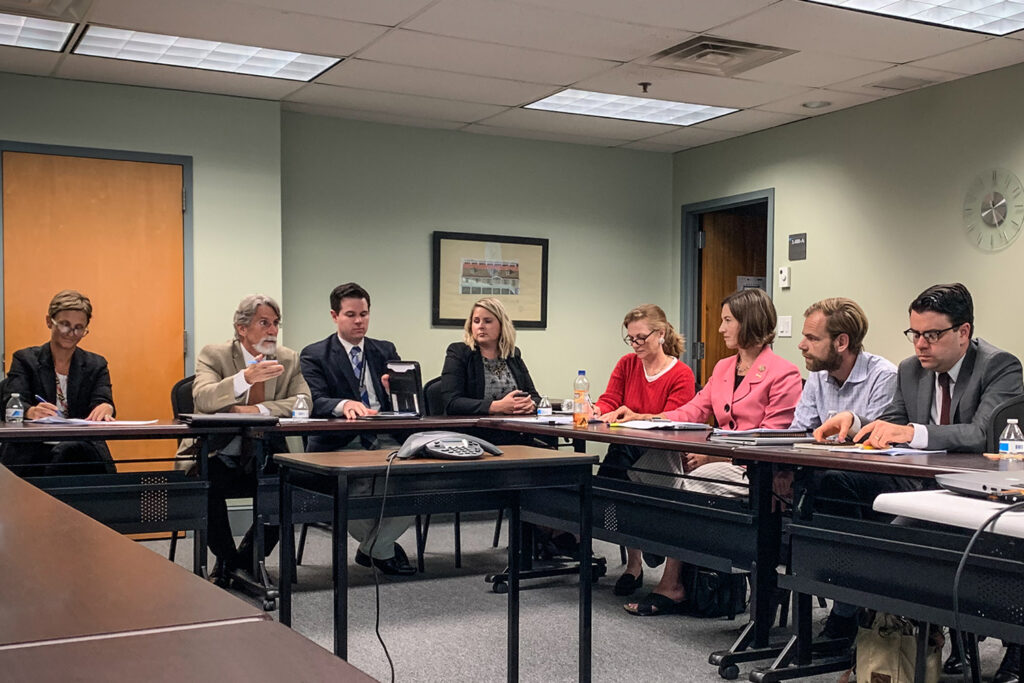
Steering Committee Meeting; Sec. Robert McCord (L, with hand extended) and Senator Katie Fry Hester (R, in pink)
The 2019 Maryland legislative session was an important springboard for the future of Maryland’s (presently or formerly) state-owned historic complexes. Senator Katie Fry Hester sponsored a bill that was ultimately signed into law that required the Maryland Department of Planning to commission a study on the problem of preserving and rehabilitating these properties, namely the funding gap not covered by the existing historic tax credit and other programs. We spent the rest of the year working with a steering committee, headed by Secretary of Planning Robert McCord, and the state’s consultant to complete the study.
The study was released in January 2020 and was the basis for legislation in the 2020 session that would have directly benefited Warfield. This bill, also sponsored by Senator Hester, proposed a new historic tax credit program – called the “catalytic” tax credit – focused exclusively on rehabilitating large state complexes and returning them to productive use. Unfortunately, the COVID-19 crisis ended the legislative session prematurely and killed any hopes for passage of the bill and establishment of the program in 2020.
As we head into the 2021 session, legislators no doubt will be focused on budgetary and other issues related to the pandemic. Still, Senator Hester will be reintroducing the catalytic tax credit bill, and we at Warfield will work hard to promote this important bill with her over the next couple of months. We will delve into the details of the proposed tax credit program in a future article.
Warfield is featured prominently in the study as one of three case studies, outlining the history of the complex, the challenges and opportunities inherent in taking on rehabilitation and redevelopment, and specific recommendations. Some of the generalized recommendations that would benefit all historic complexes statewide and are applicable to Warfield included:
- Provide incentives in the MD Historic Revitalization Tax Credit program specifically targeted to the redevelopment of state-owned historic complexes, by eliminating the per-project and annual appropriation dollar caps.
- Increase the MD Historic Revitalization Tax Credit by five percentage points from 20% to 25% for divested government-owned historic complexes.
- Establish a “catalytic” category in the MD Historic Revitalization Tax Credit program patterned after Ohio’s state historic tax credit (previously discussed above).
- Permit the MD historic revitalization tax credit to be transferred by developers to third parties.
- Provide an option for property tax abatement in addition to tax increment financing.
- Increase funding for the Strategic Demolition Fund and improve access to this fund for divested government-owned properties.
In addition to the above, the study made additional recommendations specific to Warfield including:
- Explore the availability of funding from the State of Maryland for environmental remediation, building stabilization, and selective demolition using Strategic Demolition Fund and Historic Revitalization Tax Credit funds.
- Explore the availability of funding from the State of Maryland for the demolition of the decommissioned water tower located in Parcel H and relocation of the connected 12” water main that serves both Warfield and state-owned facilities located along Buttercup Road.
- Perform an updated study to identify necessary infrastructure improvements on or near the Warfield property that may benefit Warfield and government-owned properties in the immediate vicinity.
- Explore land-use changes that will permit redevelopment of the Warfield campus in a manner that is responsive to existing market demand based on updated market and feasibility study findings.
- Explore the transfer to the current owner of Warfield certain surplus land and buildings owned by the State of Maryland and part of the Springfield Hospital Center and Maryland Police and Correctional Training Commissions campuses to support the redevelopment of the Warfield campus.
We will be discussing the finer points of some of these recommendations in future articles.
For more information, you can read the state study online – it provides a good foundation of understanding the importance of the Warfield project, as well as the long road ahead in terms of sourcing the necessary funds for rehabilitation and redevelopment.
